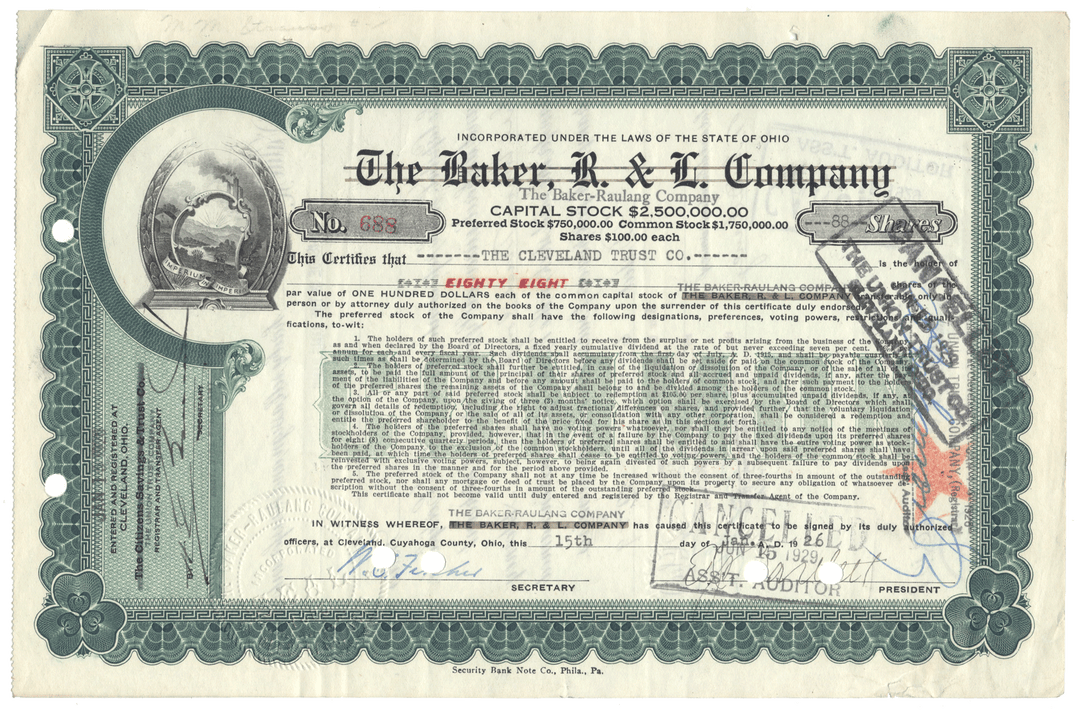
Baker, R. & L. Company (Rauch & Lang)
- Guaranteed authentic document
- Orders over $75 ship FREE to U. S. addresses
Product Details
Company
Baker, R. & L. Company
Certificate Type
Common Stock
Date Issued
January 15, 1926
Canceled
Yes
Printer
Security Bank Note Company
Signatures
Hand signed
Approximate Size
11 1/4" (w) by 7 1/4" (h)
Images
Show the exact certificate you will receive
Guaranteed Authentic
Yes
Additional Details
NA
Historical Context
By 1908, the Baker Motor Vehicle Company had "the largest (factory) in America devoted exclusively to electric carriage manufacture," Its building had "the most modern and approved architecture - light, convenient - (and) equipment of the most modern devices." Yet, the factory proved inadequate in meeting the demand for electric vehicles. The company had a 300% increase in business in 1909, forcing it to keep the plant in operation 24 hours a day.
In 1910, the company began producing Its first electric trucks and in 1912, its first electric patrol wagons. Although both vehicles were immediately popular, their sales gradually declined as owners realized the inconvenience of frequent rechargings and of slow hill-climbing speeds. The Baker Motor Vehicle Company addressed those problems by constructing several recharging stations in the major stations. Its largest opened in 1910 at E. 71st Street and Euclid Avenue, near Cleveland's wealthy ease side. Baker hoped to have recharging stations at every major intersection, an idea scoffed at although eventually realized by the gasoline automobile producers and the oil companies.
In 1912, Baker, like Rauch and Lang, reacted to the growing dominance of medium-priced gasoline cars by emphasizing the elegance and expense of its electric vehicles. That year, Baker began using the Louis XIV style on its car interiors, calling its vehicle "The Aristocrat of Matordom." In 1914, the company went even further, hiring a French fashion designer to make its decorating decisions.
Wisely, The Baker Motor Vehicle Company battled the gasoline automobile producers with mechanical innovations as well. During the latter part of the 19th century, an inventor named Justin Entz developed an engine which used a gasoline generator to drive an electric motor. Manufactured by the Pope Electric Vehicle Company until its failure in 1907, the Entz engine remained out of production until Walter Baker bought the patent rights in 1912, The R. M. Owen Company in New York City began producing the engine for its Owen Magnetic car under Baker's license. By 1915, the Baker Motor Vehicle Company decided that it needed a new product to give it a competitive edge on gasoline auto companies. As a result, Baker merged with the Rauch and Lang Carriage Company and the R. M. Owen Company to form the Baker R & L Company with a capitalization of $2,500,000. Soon after the Merger, General Electric invested in the company, raising its authorized capitalization to $5,000,000 and placing three General Electric representatives on the Baker R & L board.
Continuing in its manufacture of electric vehicles, the company's first Owen Magnetic cars went into production in December, 1915. The former Baker plant manufactured the engine and chassis for the Owen Magnetic. The former Rauch and Lang plant made Baker R & L electric cars as well as bodies for the Owen Magnetic. The New York Owen plant became a service center for the Owen Magnetic while General Electric's Fort Wayne plant made the car's electric unit.
The Entz engine proved difficult to manufacture, making the Owen Magnetic, in 1918, the third most expensive automobile in the nation. America's entrance into World War I saved the Baker R & L Company from impending failure. The company's war work included the manufacture of electric bomb handlers and lift trucks. Recognizing the potential of the electric lift truck field, the Baker R & L Company ceased its production of the Baker R & L electric and the Owen Magnetic cars in mid-1919. It reorganized later that year as The Baker Raulang Company, manufacturing electric lift trucks at the Baker plant and assembling the truck bodies at the Rauch and Lang plant. The latter plant also continued its production of automobile bodies for other companies.
Related Collections
Additional Information
Certificates carry no value on any of today's financial indexes and no transfer of ownership is implied. All items offered are collectible in nature only. So, you can frame them, but you can't cash them in!
All of our pieces are original - we do not sell reproductions. If you ever find out that one of our pieces is not authentic, you may return it for a full refund of the purchase price and any associated shipping charges.





